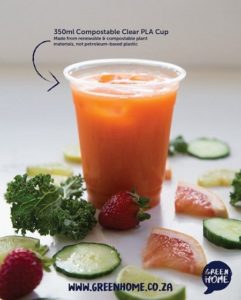The Pros and Cons of Bioplastics
Products made from bioplastic look, behave and feel like conventional clear plastic products. The use of bioplastics is becoming increasingly popular. Let’s have a look at the advantages and disadvantages.
But first we need to clear up some confusion around the term bioplastic. The term applies to a wide group of materials. According to European Bioplastics, plastic materials are defined as bioplastics if they are either biobased, biodegradable, or feature both properties.
This article focusses on bioplastics which are both biobased and biodegradable. So, we’re talking about compostable bioplastics that are made entirely from renewable plant materials.
The Pros of Bioplastics
- Bioplastics are made from plant raw materials instead of petroleum oil, the raw material used to make conventional plastics. No oil drilling, coal mining or fracking are needed to make plant-based bioplastics.
- Plant raw materials are renewable and sustainable unlike oil which is a limited and finite resource.
- The carbon footprint of manufacturing bioplastics is reportedly 75% lower than that of PET and PS alternatives i.e. their manufacture is kinder to the environment.
- Bioplastics are non-toxic and won’t leach chemicals into food or soil. According to a study conducted by The National Center for Biotechnology Information in America; plastics (including BPA free plastics) leach estrogen-like chemicals into food. There are also many studies that show that plastics can leach toxic chemical additives into the environment and landfills. Compostable bioplastics break down into harmless natural and safe compounds.
- Bioplastics are biodegradable and compostable.
- There are a variety of zero waste end of life options for bioplastics. Bioplastics can be recycled, they can be cleanly incinerated and industrially composted. This is makes bioplastics a great material for food packaging as used packaging does not require cleaning since food and packaging can be composted or incinerated together. An additional benefit of composting is that nutrients from food waste are returned to soil to nurture new plants, improving soil fertility and food security.
The Cons of Bioplastics
We’ve included arguments against bioplastics because some of these supposed cons require debunking.
- Growing demand for bioplastics creates competition for food sources, contributing to the global food crisis. This is a misleading argument commonly used against bioplastics. The raw material for bioplastics is an industrial-grade corn which is not grown for human consumption. Recent technological developments in the bioplastics industry have shown that that it is possible to make biodegradable bioplastics from hemp, seaweed and other plants. As the market grows, we can expect to see many new innovative production approaches. Humans have always used plants for non food purposes.
- Bioplastics won’t biodegrade in a landfill. Landfills are not designed to break anything down. They are huge compacted piles of waste that we don’t know what to do with. No organic waste breaks down well (if at all) in a landfill. The bottom line is we shouldn’t be sending any organic waste to landfill and should design a circular system which includes composting and ideally doesn’t require any landfills.
Unfortunately landfills remain the last stop for many plastics. We believe the benefits of a lower carbon footprint to produce bioplastic products and the fact that they offer the potential for composting as a new way of achieving zero waste sets them apart. Plus, they don’t leach toxic chemicals; there are many studies showing that plastics leach harmful chemicals, in and out of landfills. - Bioplastics encourage people to litter more. We hope not and do not encourage littering with our products. (Don’t let us catch you!) Littering is a human behaviour, which requires education, raised awareness and a good infrastructure to be reduced.
- Bioplastics contaminate plastic recycling streams. This is another myth. Recycling systems are excellent at separating different materials, and need to be because there are a great deal of different plastic types and they all need to be separated before they have any chance of being recycled. Compostable bioplastics do not pose more of a threat than any other of the many types of plastic. Bioplastics can also be recycled and the recycling market will grow as bioplastics are used more and more.
- Bioplastics are not the answer to marine litter. We agree. You can read why bioplastics are not the answer to marine litter here.
At GREEN HOME we supply you with several types of plant-based and compostable bioplastic products. These products are made from renewable corn starch and wood cellulose.
They include our Hot Cups, which are lined with a thin layer of corn starch bioplastic to make them watertight (most disposable coffee cups are lined with non-biodegradable plastic). The Compostable Lids for our Hot Cups are also made from corn starch. We also stock Cutlery, Deli Bowls, and other a number of other products, all of which can be seen on our online shop.


Read the facts about plastic from renewable plant-based matter, there is NO effect on food crops, and manufacturing 1,000,000 tonnes of Bioplastic would REDUCE CO2 emmissions by 4,000,000 tonnes per annum, whereas using petro-plastics will onle EVER add to CO2 in the atmosphere.
http://www.european-bioplastics.org/index.php?id=151
Read section 6 of the FAQ file here
http://www.european-bioplastics.org/index.php?id=191
For the best bioplastics made from potato and corn starch, go to
http://www.stanelcoplc.com
.